A Study on the Pore and Strength Characteristics of an Eco-Friendly Sprayed Ultra High Performance Concrete with Manufactured Sand
Abstract
1. Introduction
2. Experimental Materials and Methods
2.1. Materials
2.2. Preparation of the Sprayed UHPC and Cast UHPC Specimens
- (1)
- Dry mixing of the PC, SF, WRT, and MS took place for 1–2 min at a speed of 65 rpm; the subsequent addition of water and SP with continued mixing for 6–8 min to form a homogeneous slurry; and a final incorporation of PP fibers with additional mixing for 2–3 min to ensure uniform dispersion occurred. After mixing, a flow expansion test was carried out to evaluate the concrete’s flowability. The total mixing time was controlled within 15 min, and the fresh slurry was required to be sprayed within 40 min.
- (2)
- Before commencing the spraying operation, the air compressor should be activated to maintain a constant pressure of 0.6 MPa in the air receiver tank. Subsequently, the UHPC slurry was poured into the hopper of the wet-spray machine, with the slurry pumping speed maintained at 3–5 m3/h. To ensure operational safety, the procedure requires that the high-pressure air be turned on before the UHPC slurry is pumped. Referencing the Chinese standard GB 50086–2015 [26], with the assistance of high-speed air, the UHPC slurry was sprayed into the mold (450 mm × 450 mm × 120 mm). During the spraying process, the spray nozzle should be perpendicular to the mold and maintain a distance of 1.3–1.7 m.
- (3)
2.3. Experimental Methods
2.3.1. Mechanical Performance Tests
2.3.2. Porosity Test
2.3.3. SEM Analysis
3. Experimental Results and Discussion
3.1. Mechanical Properties
3.2. The Porosity and Microstructure
3.3. Engineering Application
4. Conclusions
- (1)
- The mechanical properties of the sprayed UHPC material were examined through a series of strength tests. Experimental results demonstrated that by incorporating manufactured sand into the UHPC matrix, the mechanical properties of sprayed UHPC are comparable to those of cast UHPC across various spraying orientations, confirming its structural reliability for practical applications. This study offers robust theoretical underpinnings and practical guidance for the development of sustainable green sprayed UHPC, effectively driving down UHPC costs and advancing its progress in environmental protection and resource recycling.
- (2)
- The pore characteristics of the sprayed UHPC material were revealed through advanced microstructural analysis using SEM. The pore structure was primarily characterized by isolated and non-interconnected micropores with diameters smaller than 100 nm. The high pressure air-driven spraying technique effectively prevented the formation of harmful macropores larger than 10 μm, thereby enhancing the mechanical properties of the material. This process simultaneously reduced early age porosity and improved pore connectivity in the UHPC, providing a critical reference for advancing research on enhancing UHPC durability through process optimization.
- (3)
- The early age strength development and low rebound rate of sprayed UHPC were validated through field tests. A compressive strength of 30 MPa was achieved within 24 h, reaching 60 MPa within 48 h, while the rebound rate remained consistently below 5%. The systematic refinement of indoor spraying process parameters, which integrates material fundamentals with engineering considerations, establishes a robust theoretical framework and actionable technical guidelines for implementing sprayed UHPC technologies. This study offers pivotal insights into the technological evolution of sprayed UHPC systems, thereby expanding their applicability in specialized domains such as tunneling and underground construction.
Author Contributions
Funding
Institutional Review Board Statement
Informed Consent Statement
Data Availability Statement
Conflicts of Interest
References
- Zheng, Z.; Feng, X.T. Influence of Intermediate Principal Stress on the Mechanical Properties of Rocks Containing Fractures. Geotech. Lett. 2020, 10, 82–87. [Google Scholar] [CrossRef]
- Sun, B.-J.; Mei, Y.-C.; Li, W.-T.; Zhang, C.-A.; Shao, X.; Li, T.-C.; Li, W.-X.; Zhao, W.-X.; Wang, L.-P. Experimental Study on the Deformation and Failure Mode of Surrounding Rocks of a Tunnel in a Jointed Rock Mass. Eng. Fail. Anal. 2024, 163, 108470. [Google Scholar] [CrossRef]
- Bajaber, M.A.; Hakeem, I.Y. UHPC Evolution, Development, and Utilization in Construction: A Review. J. Mater. Res. Technol. 2021, 10, 1058–1074. [Google Scholar] [CrossRef]
- Sun, B.-J.; Mei, Y.-C.; Li, W.-T.; Li, T.-C.; Li, H.-Z.; Yang, G.-H. Study on Displacement Mode and Structural Failure of Jointed Surrounding Rock of Shallow Buried Tunnel under Tectonic Stress. Structures 2024, 70, 107809. [Google Scholar] [CrossRef]
- Zhang, M.; Fan, J.; Li, Z.; Jiang, D.; Chen, J.; Nelias, D. Failure analysis and enhancement measures of wet shotcrete support during cold periods in mining. Constr. Build. Mater. 2025, 461, 139769. [Google Scholar] [CrossRef]
- Asheghi Mehmandari, T.; Shokouhian, M.; Imani, M.; Fahimifar, A. Experimental and numerical analysis of tunnel primary support using recycled, and hybrid fiber reinforced shotcrete. Structures 2024, 63, 106282. [Google Scholar] [CrossRef]
- Li, Y.; Shen, S.; Gao, S. The Suppression Effect of Surface-Sprayed Materials on Rock Ejection Failure in Deep Tunnels: An Experimental Study. Tunn. Undergr. Space Technol. 2024, 150, 105860. [Google Scholar] [CrossRef]
- Yan, Z.; Zhang, J.; Fan, Z.; Chen, P.; Fu, J.; Ma, K.; Feng, J.; Chen, J.; Wang, S. Effect of isobutyltriethoxysilane-zeolite powder (IBTES-ZP) on impermeability of shotcrete and application. Constr. Build. Mater. 2024, 435, 136812. [Google Scholar] [CrossRef]
- Wang, I.; Islam, M.M.; Zhang, Q. Influence of materials and nozzle geometry on spray and placement behavior of wet-mix shotcrete. Case Stud. Constr. Mater. 2024, 20, e02852. [Google Scholar] [CrossRef]
- Du, J.; Meng, W.; Khayat, K.H.; Bao, Y.; Guo, P.; Lyu, Z.; Abu-Obeidah, A.; Nassif, H.; Wang, H. New Development of Ultra-High-Performance Concrete (UHPC). Compos. Part B Eng. 2021, 224, 109220. [Google Scholar] [CrossRef]
- Ma, H.; Bai, Q.; Xin, Z.; Qi, J.; Liu, H.; Shao, H. Utilization of graphite tailings as a replacement for quartz sand in UHPC: Macro-performance and microstructure. J. Build. Eng. 2025, 99, 111469. [Google Scholar] [CrossRef]
- Hou, D.; Zhang, X.; Zhang, K.; Zhang, X.; Bao, M.; Jin, L.; Han, Z.; Zhang, Y.; Wang, X. Optimizing lightweight UHPC through the synergy of lightweight aggregate, filler, and polymer fiber via response surface methodology. Constr. Build. Mater. 2025, 463, 140104. [Google Scholar] [CrossRef]
- Liu, J.; Cai, P.; Liu, C.; Liu, P.; Su, Y.; Xu, S.; Wu, C. Mechanical properties of geopolymer-based ultra-high performance concrete with ceramic ball coarse aggregates. J. Clean. Prod. 2023, 420, 138318. [Google Scholar] [CrossRef]
- Xue, J.; Briseghella, B.; Huang, F.; Nuti, C.; Tabatabai, H.; Chen, B. Review of Ultra-High Performance Concrete and Its Application in Bridge Engineering. Constr. Build. Mater. 2020, 260, 119844. [Google Scholar] [CrossRef]
- Li, F.F.; Yao, T.S.; Luo, J.J.; Song, Q.L.; Yang, T.L.; Zhang, R.; Cao, X.C.; Li, M.Y. Experimental investigation on the performance of ultra-high performance concrete (UHPC) prepared by manufactured sand: Mechanical strength and micro structure. Constr. Build. Mater. 2024, 452, 139001. [Google Scholar] [CrossRef]
- Yang, R.; Yu, R.; Shui, Z.; Guo, C.; Wu, S.; Gao, X.; Peng, S. The physical and chemical impact of manufactured sand as a partial replacement material in Ultra-High Performance Concrete (UHPC). Cem. Concr. Compos. 2019, 99, 203–213. [Google Scholar] [CrossRef]
- Cui, J.; He, Z.; Zhang, G.; Cai, X. Rheological properties of sprayable ultra-high performance concrete with different viscosity-enhancing agents. Constr. Build. Mater. 2022, 321, 126154. [Google Scholar] [CrossRef]
- Chen, F.X.; Leng, Y.; Zhang, G.Z.; Wei, K.; Jin, L.; Yin, T.Y.; Yu, R. Revealing the effect of hydroxyethyl methyl cellulose ether on rheological characteristics and hydration kinetics of Ultra-High Performance Concrete with high thixotropy. Constr. Build. Mater. 2024, 457, 139388. [Google Scholar] [CrossRef]
- Cui, J.; He, Z.; Zhang, G.; Cai, X.; Hu, L. Rheology, Mechanical Properties and Pore Structure of Sprayed Ultra-High Performance Concrete (SUHPC) with Viscosity-Enhancing Agent. Constr. Build. Mater. 2022, 350, 128840. [Google Scholar] [CrossRef]
- Chen, F.X.; Yang, R.H.; Wang, Z.Y.; Zhang, G.Z.; Yu, R. Rheological Analysis and Molecular Dynamics Modeling of Ultra-High Performance Concrete for Wet-Mix Spraying. J. Build. Eng. 2023, 68, 106167. [Google Scholar] [CrossRef]
- Al-Ameen, E.; Blanco, A.; Cavalaro, S. Durability, Permeability, and Mechanical Performance of Sprayed UHPC, as an Attribute of Fiber Content and Geometric Stability. Constr. Build. Mater. 2023, 407, 133393. [Google Scholar] [CrossRef]
- Guler, S.; Öker, B.; Akbulut, Z.F. Workability, Strength and Toughness Properties of Different Types of Fiber-Reinforced Wet-Mix Shotcrete. Structures 2021, 31, 781–791. [Google Scholar] [CrossRef]
- GB 175-2007; General Portland Cement. China Building Material Federation. China Concrete & Cement-Based Products Association: Beijing China, 2007.
- Yin, T.; Yu, R.; Liu, K.; Wang, Z.; Fan, D.; Wang, S.; Feng, Y.; Shui, Z. Precise Mix-Design of Ultra-High Performance Concrete (UHPC) Based on Physicochemical Packing Method: From the Perspective of Cement Hydration. Constr. Build. Mater. 2022, 352, 128944. [Google Scholar] [CrossRef]
- Lin, J.X.; Luo, R.H.; Su, J.Y.; Guo, Y.C.; Chen, W.S. Coarse synthetic fibers (PP and POM) as a replacement to steel fibers in UHPC: Tensile behavior, environmental and economic assessment. Constr. Build. Mater. 2024, 412, 134654. [Google Scholar] [CrossRef]
- GB 50086-2015; Technical Specification for Anchorage and Shotcrete Support in Rock and Soil Engineering. Ministry of Housing and Urban-Rural Development of the People’s Republic of China. China Construction Industry Press: Beijing China, 2015.
- GT/T 50081-2016; Standard for Test Method of Mechanical Properties on Ordinary Concrete. China Quality and Standard Publishing & Media Co., Ltd.: Beijing China, 2017.
- Tian, H.M.; Zhang, T.; Xu, Y.L.; Tan, X.J.; Shu, X.Y.; Yang, C.M. Experimental investigation of the effect of train load on mechanical properties of rock. Geotech. Lett. 2025, 15, 61–65. [Google Scholar] [CrossRef]
- T/CBMF 37–2018; Fundamental Characteristics and Test Methods of Ultra-High Performance Concrete. China Building Material Federation, China Concrete & Cement-Based Products Association: Beijing, China, 2018.
- Qin, L.; Zhai, C.; Liu, S.M.; Xu, J.Z.; Yu, G.Q.; Sun, Y. Changes in the petrophysical properties of coal subjected to liquid nitrogen freeze-thaw—A nuclear magnetic resonance investigation. Fuel 2017, 194, 149–156. [Google Scholar] [CrossRef]
- Lin, J.F.; Zhang, Y.; Guo, Z.H.; Du, H.J. Impact of synthetic fibers on spalling and intrinsic pore structure of ultra-high performance concrete (UHPC) under elevated temperatures. Constr. Build. Mater. 2024, 439, 137325. [Google Scholar] [CrossRef]
- Xu, D.S.; Tang, J.H.; Hu, X.; Zhou, Y.C.; Yu, C.; Han, F.Y.; Liu, J.P. Influence of silica fume and thermal curing on long-term hydration, microstructure and compressive strength of ultra-high performance concrete (UHPC). Constr. Build. Mater. 2023, 395, 132370. [Google Scholar] [CrossRef]
- Chu, H.; Jiang, J.; Li, H. Effects of Eco-Friendly Fine Aggregates on Mechanical Properties of Ultra-High Performance Concrete. Mater. Rep. 2024, 34, 24029–24033. [Google Scholar] [CrossRef]
- Chen, Y.J.; Jiao, Y.B.; Yang, H.; Ma, F.Z.; Meng, J. Interfacial bond behavior of steel fibers embedded in manufactured sand-based ultra-high performance concrete. Constr. Build. Mater. 2024, 446, 138041. [Google Scholar] [CrossRef]
- Ma, R.; Zhang, L.F.; Chen, Z.G.; Miao, C.B.; Zhang, C.Y.; Fan, T.F.; Zhang, J.Q.; Qian, X.Q. Utilization of solid waste from tunnel excavation as manufactured sand with different lithology and pre-washing process for preparation of eco-friendly ultra-high performance concretes: Properties and microstructural analysis. J. Build. Eng. 2024, 82, 108252. [Google Scholar] [CrossRef]
- Salvador, R.P.; Cavalaro, S.H.P.; Cano, M.; Figueiredo, A.D. Influence of Spraying on the Early Hydration of Accelerated Cement Pastes. Cem. Concr. Res. 2016, 88, 7–19. [Google Scholar] [CrossRef]
- Luo, B.; Luo, Z.; Wang, D.; Shen, C.; Xia, M. Influence of Alkaline and Alkali-Free Accelerators on Strength, Hydration and Microstructure Characteristics of Ultra-High Performance Concrete. J. Mater. Res. Technol. 2021, 15, 3283–3295. [Google Scholar] [CrossRef]
- Cheng, W.; Liu, G.; Chen, L. Pet Fiber Reinforced Wet-Mix Shotcrete with Walnut Shell as Replaced Aggregate. Appl. Sci. 2017, 7, 345. [Google Scholar] [CrossRef]
- Du, S.; Wang, W.; Qiao, M.; Zeng, L.; Zhao, S.; Chen, J.; Wu, Q.; Zhu, B. Investigation of the Relationship between Early Compressive Strength and Hydration Products of Shotcrete by Adding RMA and Accelerator at 5 °C. Constr. Build. Mater. 2025, 469, 140423. [Google Scholar] [CrossRef]

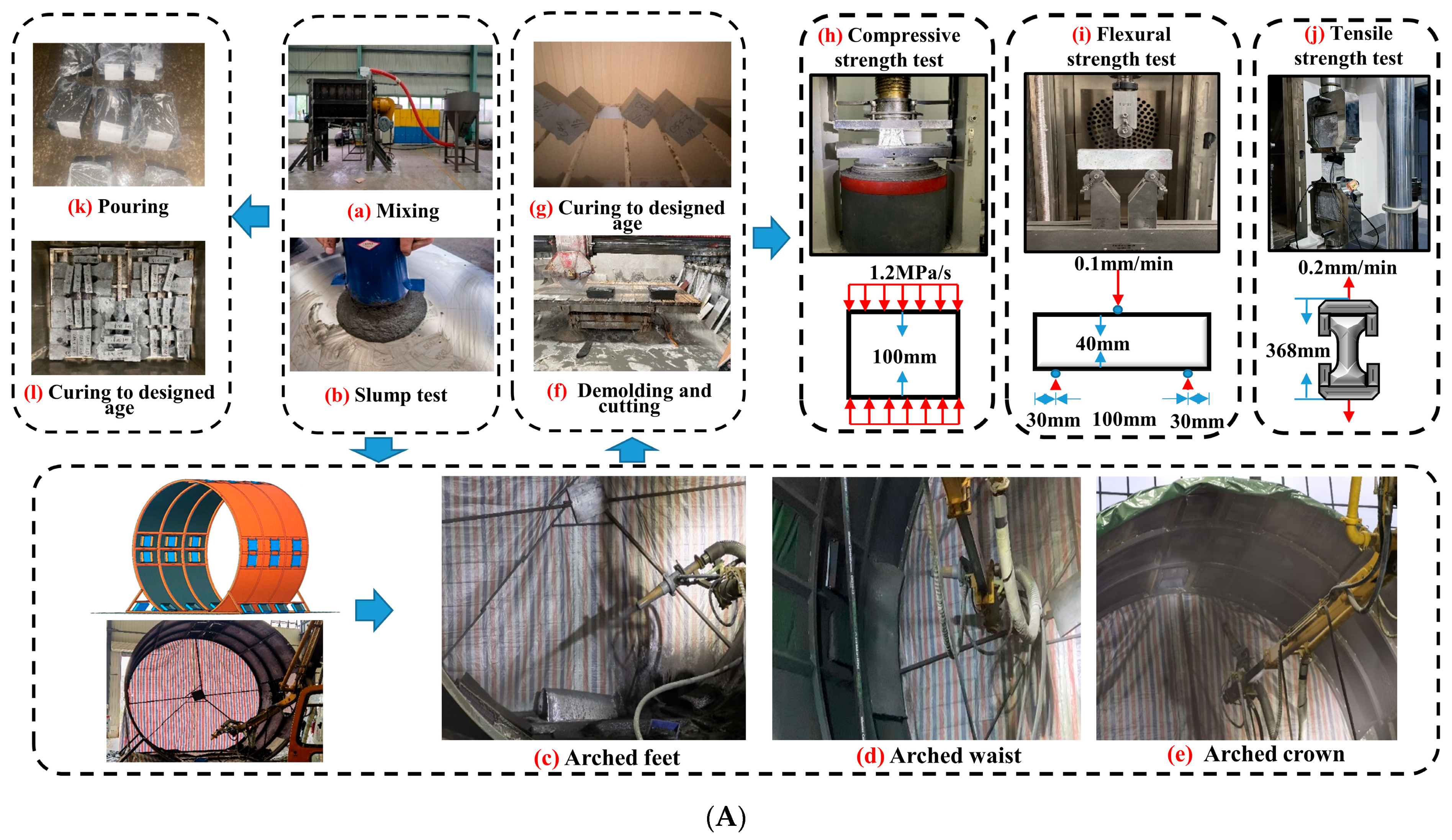
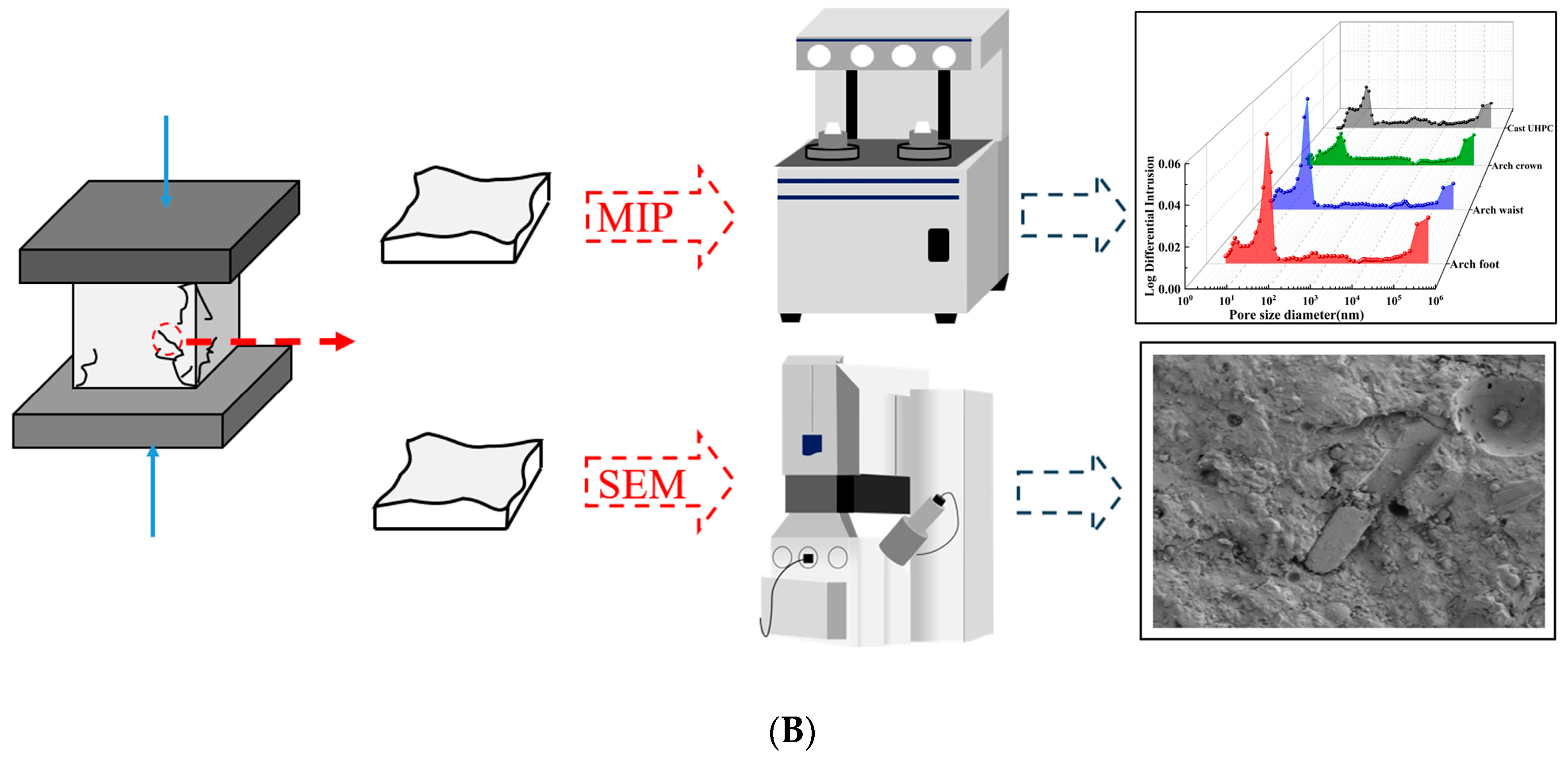

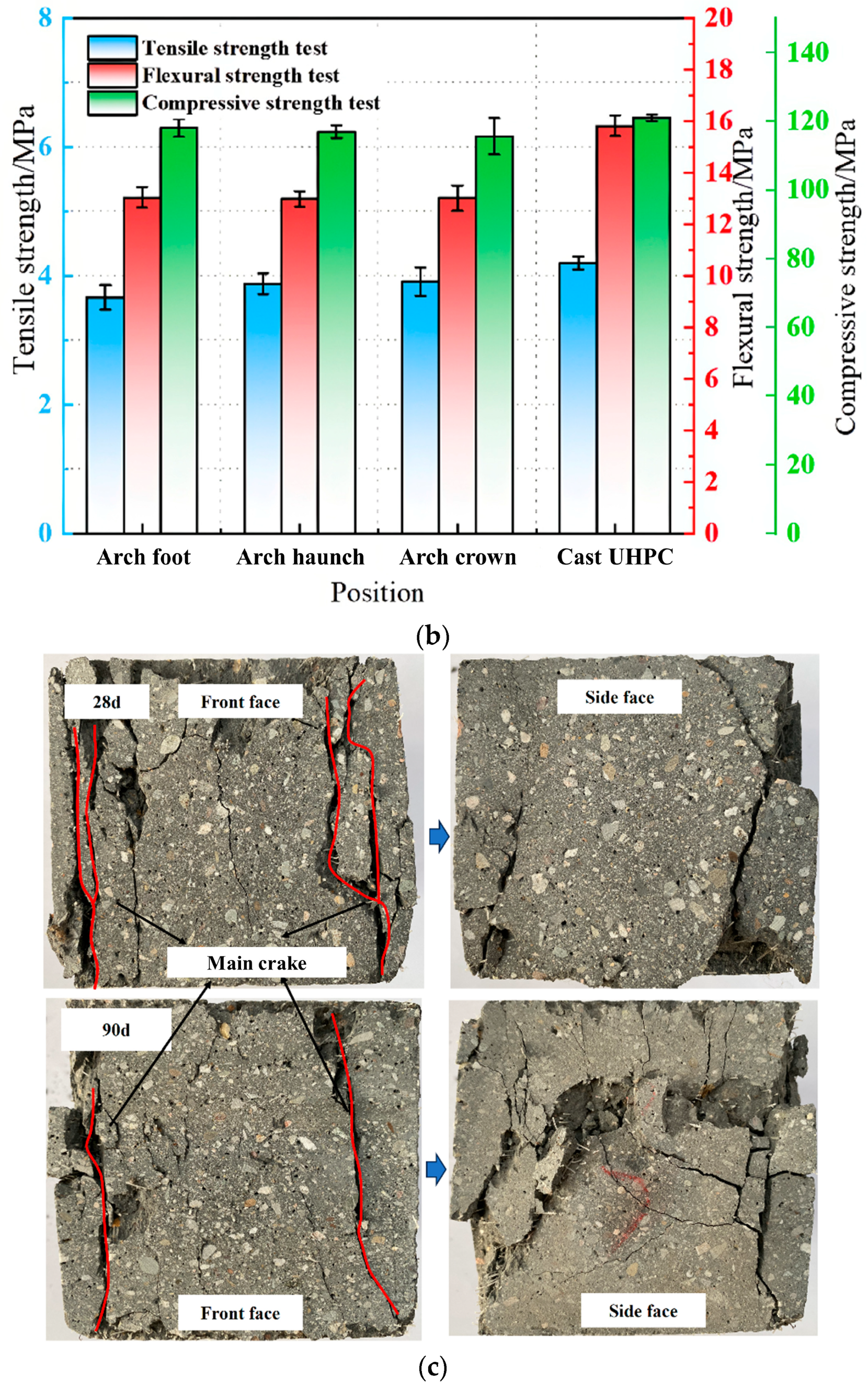
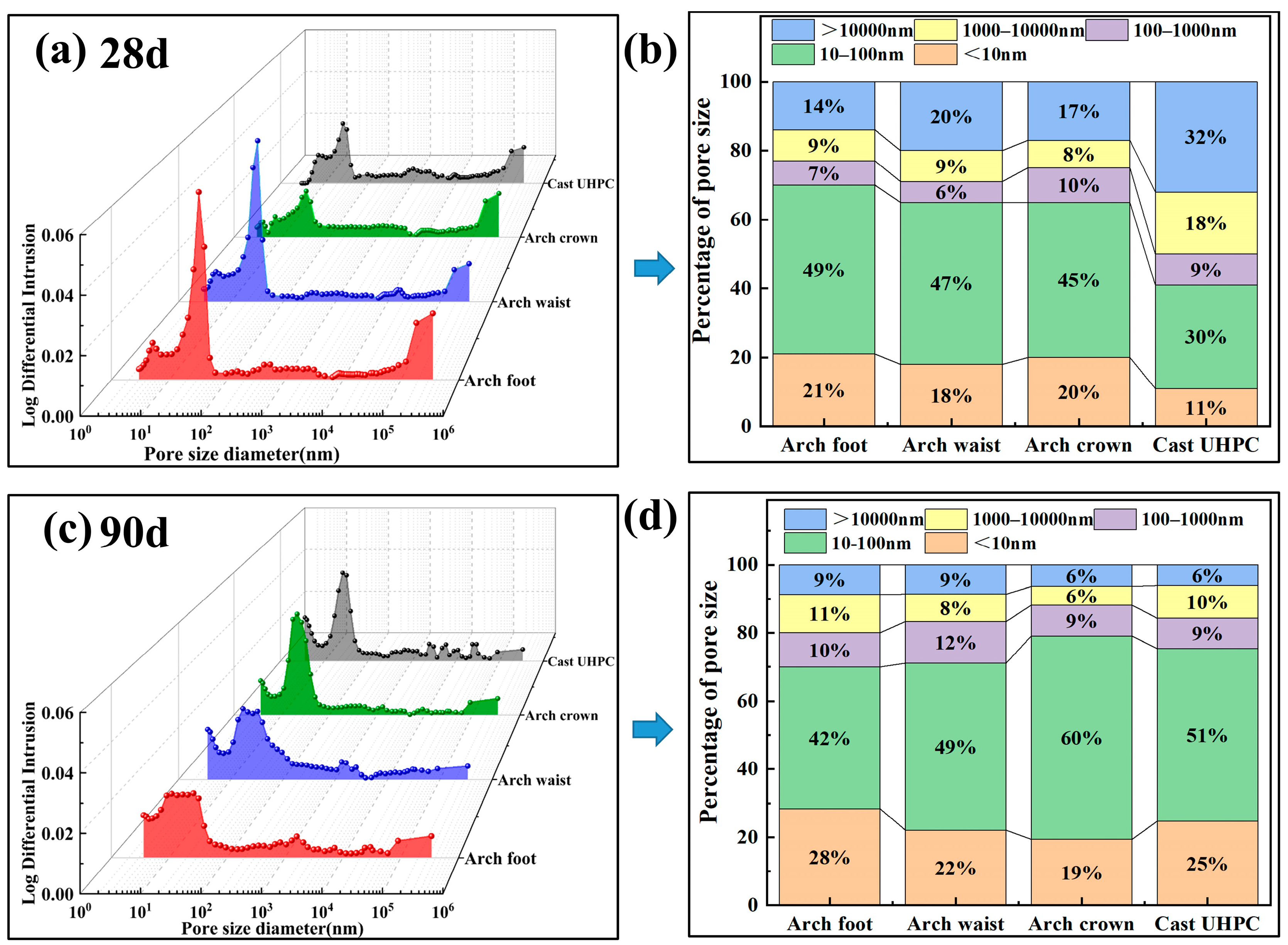
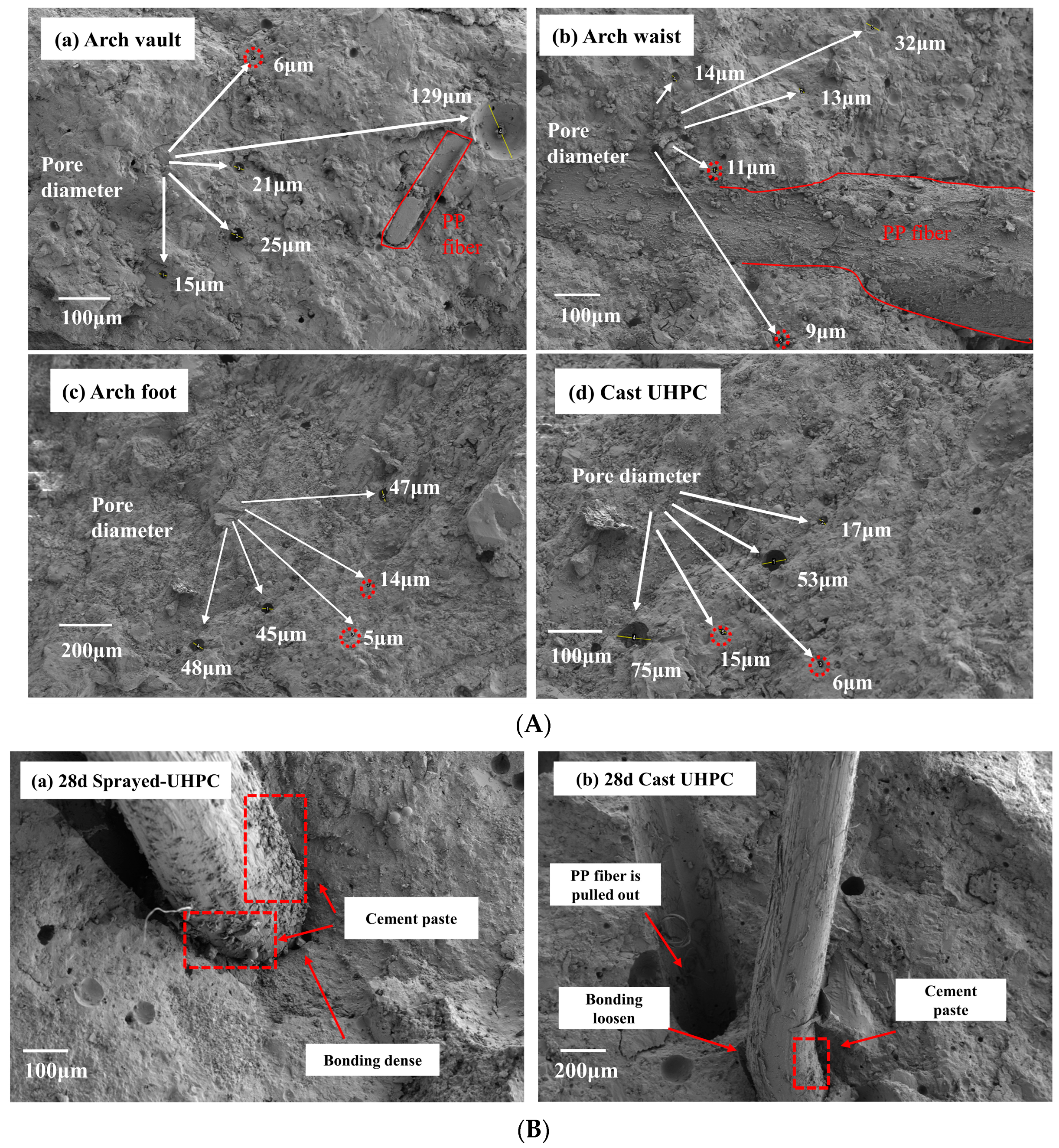
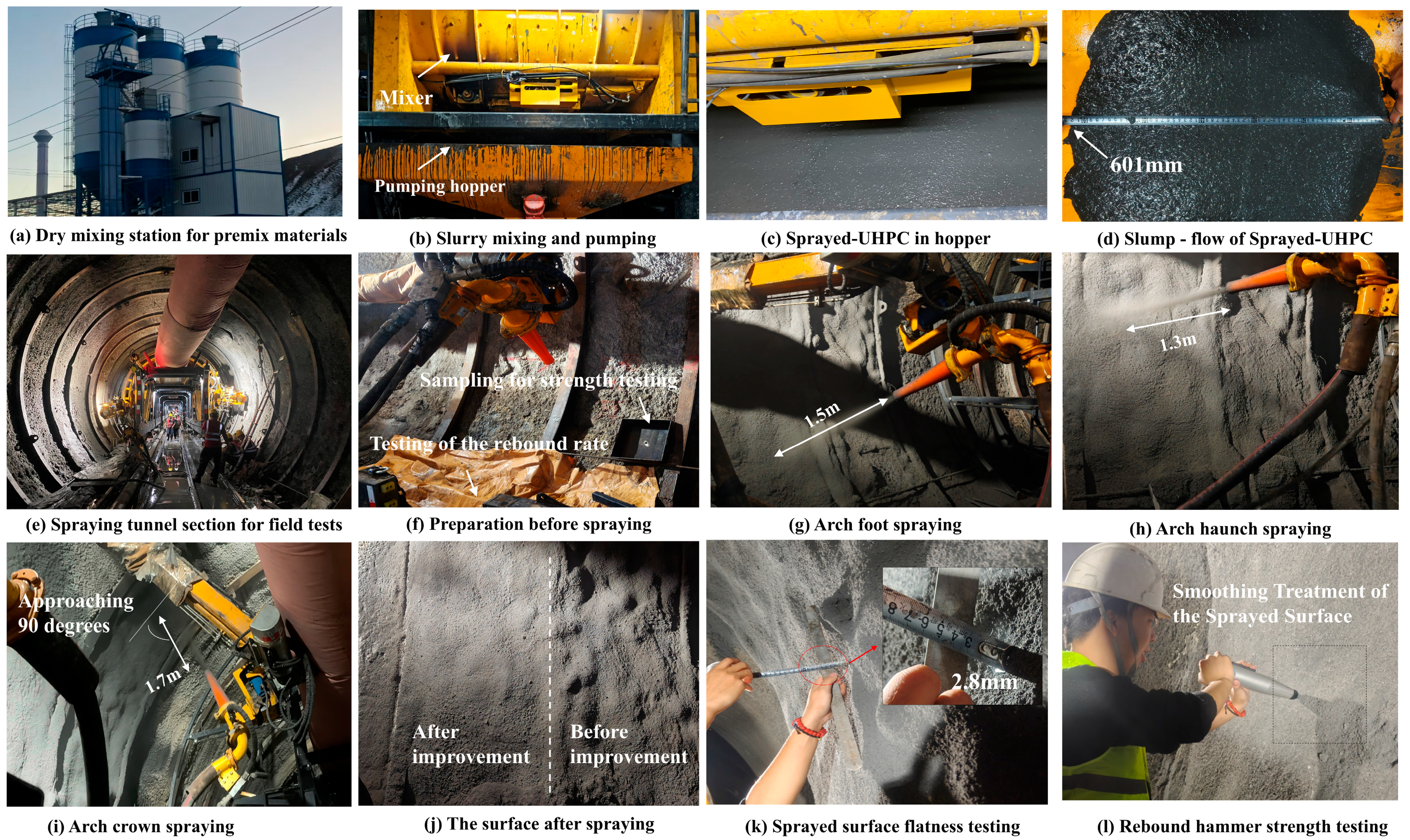
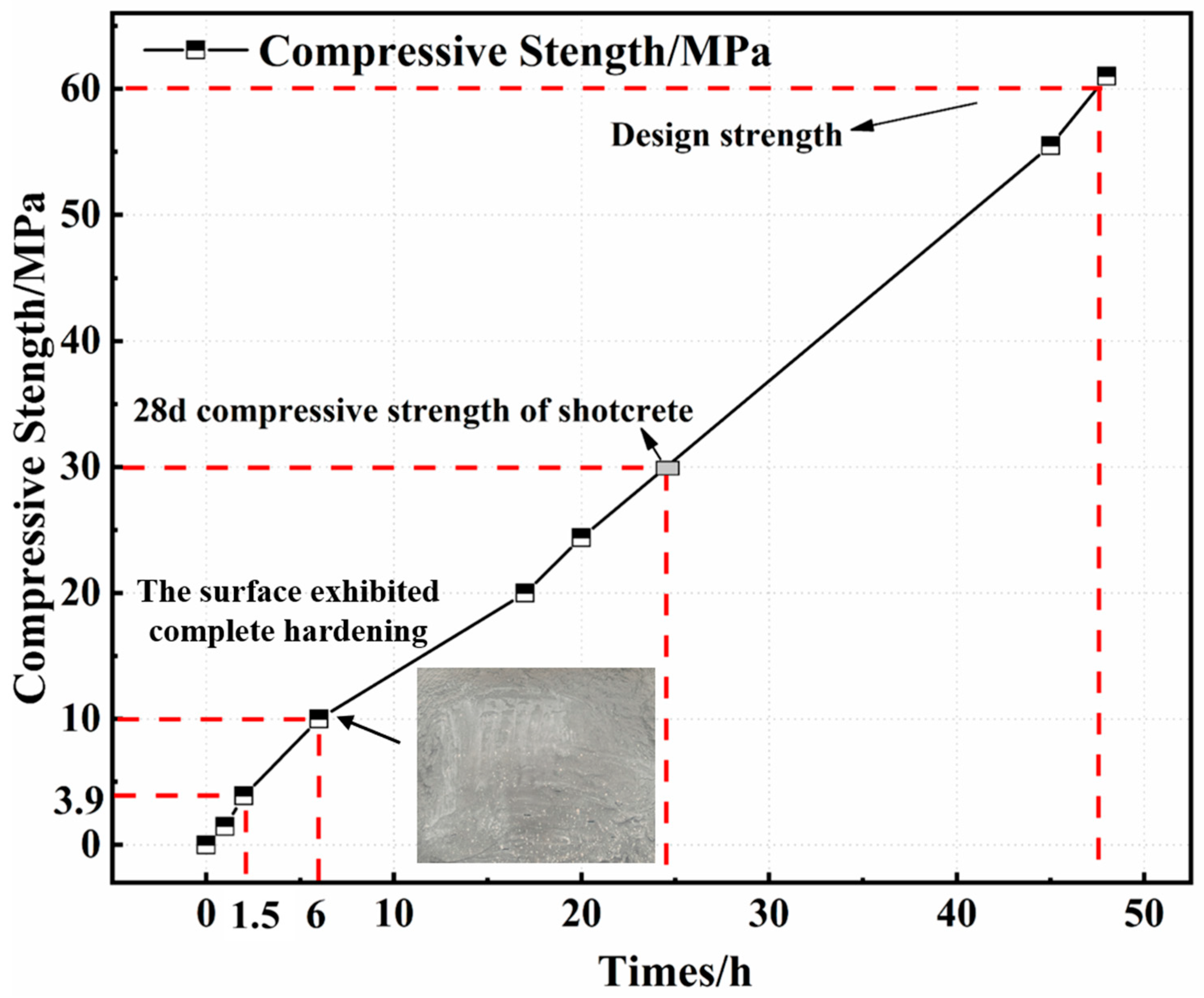
| WRT | Primary Technical Specifications |
|---|---|
| Chloride ion content | ≤0.6% |
| Alkali content | ≤1.0% |
| Compressive strength ratio | ≥100% |
| Fineness (85 μm Residue) | ≤10% |
| Setting Time Difference | −90~+120 min |
| Materials | Sprayed UHPC | Cast UHPC |
|---|---|---|
| Portland Cement | 720 | 720 |
| Silica Fume | 200 | 200 |
| WRT | 100 | 100 |
| Manufactured sand | 1070 | 1070 |
| Superplasticizer | 20 | 21 |
| Water-Binder | 0.18 | 0.18 |
| Alkali-free accelerator | 16 | 0 |
Disclaimer/Publisher’s Note: The statements, opinions and data contained in all publications are solely those of the individual author(s) and contributor(s) and not of MDPI and/or the editor(s). MDPI and/or the editor(s) disclaim responsibility for any injury to people or property resulting from any ideas, methods, instructions or products referred to in the content. |
© 2025 by the authors. Licensee MDPI, Basel, Switzerland. This article is an open access article distributed under the terms and conditions of the Creative Commons Attribution (CC BY) license (https://creativecommons.org/licenses/by/4.0/).
Share and Cite
Wang, Z.; Tan, X.; Yuan, J.; Wang, C.; Liu, Y. A Study on the Pore and Strength Characteristics of an Eco-Friendly Sprayed Ultra High Performance Concrete with Manufactured Sand. Appl. Sci. 2025, 15, 3776. https://doi.org/10.3390/app15073776
Wang Z, Tan X, Yuan J, Wang C, Liu Y. A Study on the Pore and Strength Characteristics of an Eco-Friendly Sprayed Ultra High Performance Concrete with Manufactured Sand. Applied Sciences. 2025; 15(7):3776. https://doi.org/10.3390/app15073776
Chicago/Turabian StyleWang, Zhonghao, Xianjun Tan, Jingqiang Yuan, Chongge Wang, and Yubiao Liu. 2025. "A Study on the Pore and Strength Characteristics of an Eco-Friendly Sprayed Ultra High Performance Concrete with Manufactured Sand" Applied Sciences 15, no. 7: 3776. https://doi.org/10.3390/app15073776
APA StyleWang, Z., Tan, X., Yuan, J., Wang, C., & Liu, Y. (2025). A Study on the Pore and Strength Characteristics of an Eco-Friendly Sprayed Ultra High Performance Concrete with Manufactured Sand. Applied Sciences, 15(7), 3776. https://doi.org/10.3390/app15073776






